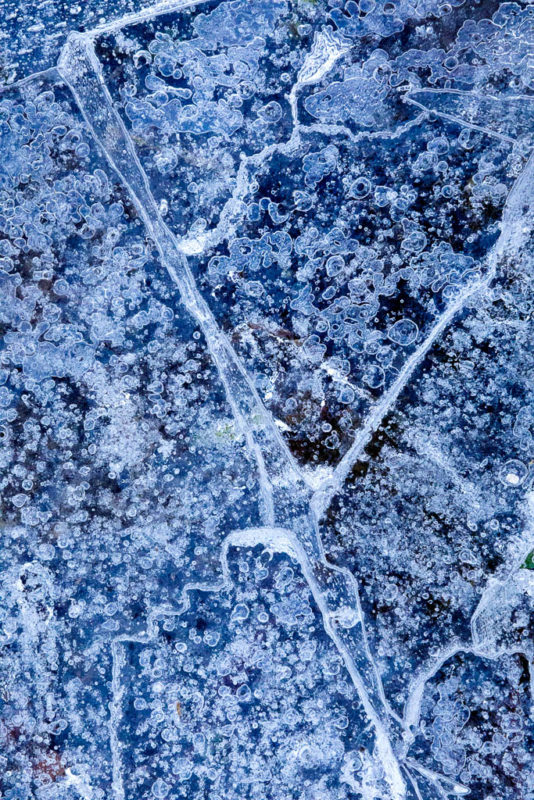Much of the country has been experiencing extremely cold weather over the last week or so, and my area has been no different with four or five consecutive days with high temperatures in the mid-20s and wind chills in the single digits or lower. Weather like this leads to all kinds of problems, but it can also provide some nice photographic opportunities.
Walking down to the pond in my backyard one morning, I discovered that it had frozen over after the several days of cold temperatures. I quickly went back in the house, grabbed my camera, and began looking for interesting patterns or designs that had formed in the ice during the freezing process. Not seeing much, I went back inside to warm up.
Later that day, the temperature warmed up and allowed the pond to begin to thaw before refreezing overnight. The next day, I went back to the pond and found that the thawing and refreezing had created numerous abstract patterns. The biggest challenge was finding clean designs that didn’t have leaves, twigs, or grass frozen in them. I found and shot several really nice patterns, but this is probably my favorite.
The main concern with this shot was ensuring complete depth of field. If any part of the image was not completely sharp, it would be failure. To ensure complete depth of field, it is imperative to ensure the plane of the sensor and the surface of the ice were as parallel as I could make them. However, there were several factors that complicated this. First, I had to handhold the camera because I wasn’t sure the ice was thick enough to support my weight as I looked through the viewfinder of a tripod-mounted camera. Second, I needed to use a shutter speed that was fast enough to offset any possible camera shake. Third, I needed to use the smallest aperture to mitigate the possibility that I could not keep the sensor parallel with the surface of the ice as I held the camera.
To address these concerns, I set the camera on manual mode, which allowed me to select both the shutter speed and aperture myself. I then used the auto ISO setting so the camera could select the necessary ISO based on my chose shutter speed and aperture. I selected a shutter speed of 1/250 of a second and aperture of f/22, and the camera selected an ISO of 8000. Although my camera, the Canon 5D Mark IV, handles digital noise very well, I normally avoid using an ISO this high. However, in this case, any digital noise was essentially absorbed by the composition.
Settings: Canon 5D Mk IV, 62mm, 1/250 sec, f/22

That’s a wise choice to stay off the ice! Nice image. I enjoy the detail you put into your posts on camera settings and such. It helps newbie photo enthusiasts like myself.
Over the years, I have read a lot of blogs and articles from a number of professional photographers. In fact, I still read several of them. The ones I always appreciated and found most helpful and educational were the ones that described not only the picture but also how they chose their settings, camera location, etc. I have also found that providing this kind of detail is also helps me reinforce in my own mind what I did so I can hopefully use that knowledge again in the future.
Pingback: 2018 Year in Review | Bob Henry Photography